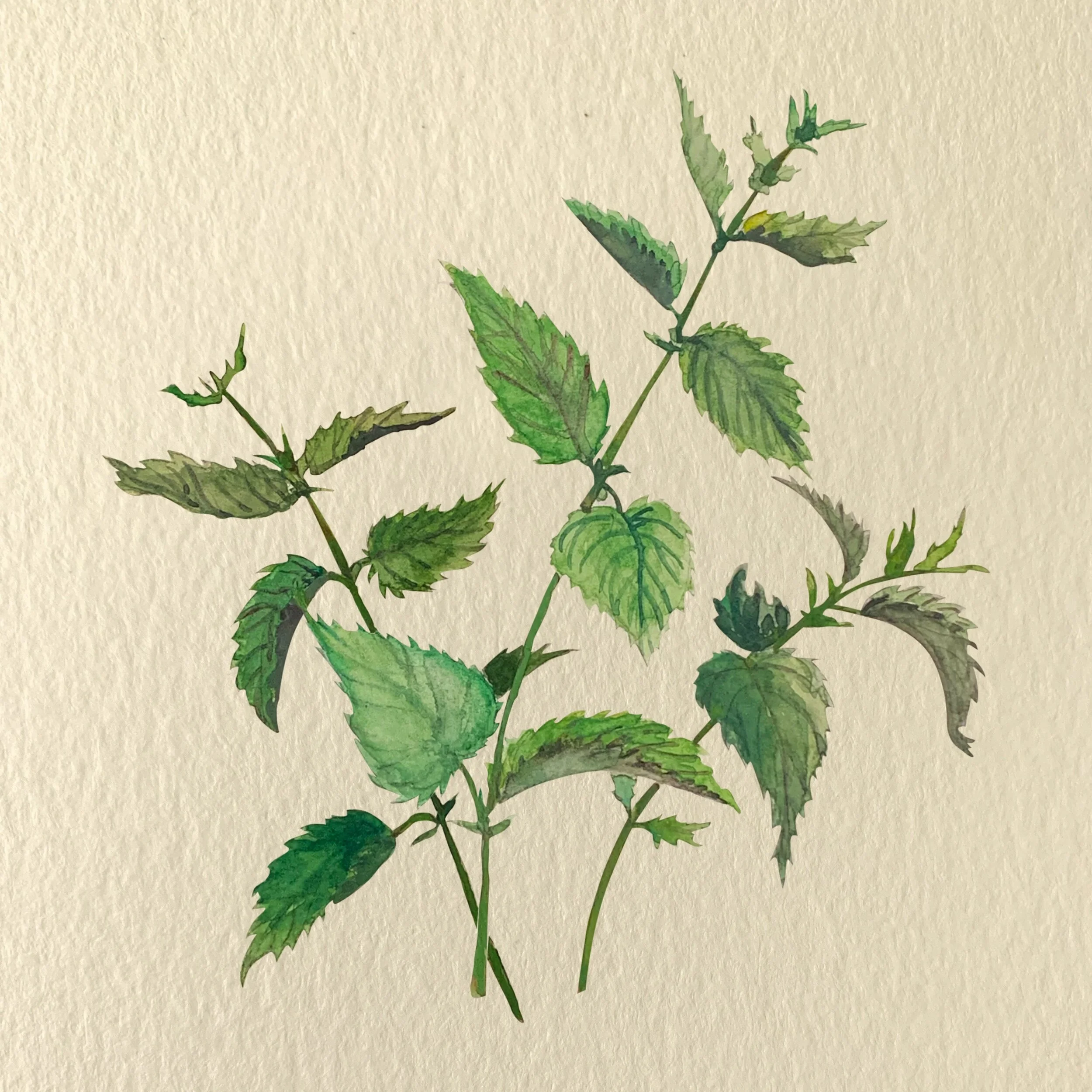Urtica dioica. Illustration by Michelle Enemark.
STINGING NETTLE
FOOD AS MEDICINE
Power Green Nettle Smoothie
Ingredients:
1 c. nettle infusion or soup
1 c. mix of dark or wild greens (e.g. dandelion, chickweed, kale, collards...)
1 ripe avocado (for creaminess)
Making a smoothie with nettle is a good way to get the herb down for pregnant mamas with morning sickness, those in recovery, and children. Make a strong nettle infusion (dried herb) or soup (fresh herb) and chill in the fridge. Blend all ingredients with ice or frozen strawberries if you want it to be cold. Can add honey sweetener.
Nettle Infusion
1 ounce dry nettle
1 quart hot water
Put the dry herb into the jar and pour over nearly boiling water (I try not to scorch the plant material). Brew overnight, strain, then refrigerate. Nettle infusion goes bad after a few days, and expiration times are shorter during hot months.
Nettle Soup: I usually make freshly harvested nettle into pot greens. I use rubber gloves to handle, give a quick rinse under the faucet, then snip off the tender tops and all healthy leaves. You can put the stem in as well and discard before eating. I fill the pot and cover with water so that there's a good broth to enjoy. Nettles only need a few minutes of simmering to take away the sting, but I have heard that cooking longer brings out more minerals. Personally, I think they’re pretty tasty after about ten minutes. Once cooked, you can enjoy on its own or add the nettle to anything, including children's smoothies or soups.
Nettle Everything: Dried nettle can be added to broths and tea mixes. Fresh nettle can be used in all sorts of recipes. I especially enjoy an emerald green nettle muffin or pesto!
MEDICINAL USES:
Nettle is for every day nourishment and it is also for the moments that define us… pregnancy and childbirth, sickness and healing, times of intense work and focus.
Nettle is a powerful blood cleanser that works to both build the blood with its many nutrients while also detoxifying. It is a go-to herb for treating lead or other poisonings of the blood. I drank it often before childbirth as it provides so many nutrients, and also helps strengthen the blood in case of hemorrhage. I have heard stories of women who lost a lot of blood due to childbirth hemorrhage, but who were able to recover without hospitalization or major medical interference. I’ve seen the effects of nettle on my own blood veins - I have small veins that are hard to find when giving blood, and nettle helps my veins to be big and easy to prick.
For those treating or recovering from Covid-19, nettle can be used to help protect and heal the kidneys, which seem to be effected in many cases. For this, one could drink nettle infusion and also take nettle seed tincture, which is specific for the kidneys. If one has issues with the kidneys in general, nettle certainly deserves some exploration.
Nettle is also used to help the body combat pollen allergies. For this, nettle should be used long term - I would begin drinking the strong infusion at least a month before allergy season begins. Nettle is not going to work as an over-the-counter anti-histamine.
For pregnant and nursing mamas, nettle can be combined with red raspberry leaf and oat straw to create a nourishing beverage. For this, I'd use about one third cup of each herb to one quart of water.
IDENTIFICATION:
You shall know “stingin’ nettle” when you reach down to stroke its beautiful dark green leaves and they scratch you back. Along the stem and on the leaves are “hairs” that contain formic acid that causes blisters on human skin. (I treat the stings with fresh jewelweed plant, stem and leaf crushed and applied, or jewelweed salve. I have heard others use dock leaves crushed. But I've never found anything that completely takes away the sting!)
The leaves are opposite, serrated, dark to dull green in color. The flowers are tiny, growing in clusters, male (4 stamens & 4 sepals) or female (one single flower), yellow-green in color. The stem has 4 ribs.
Nettle emerges in early to mid spring around here, small purple leaves and stems popping up that will eventually turn dark green. The nettle on our land grows to be four or more feet high.
HABITAT:
Nettle is a perennial plant that likes disturbed soils, edges, meadows, riverbanks, and woods openings. I often find it along trails, railroad tracks, and on former construction sites.
For those who live in the country, but don’t know of an accessible nettle patch, check with your neighbors and local farmers to see if they might have a patch of nettle they’d be willing to share with you. Many do not like the plant and would like it banished. Perhaps you could work somethin’ out…
PARTS USED:
I mostly use the leaves and stem (early growth), but the whole plant from seed to root has medicine. One should take care when they are harvesting to make the food or medicine appropriate to that time in the plant’s development. For example, once the plant flowers, the leaves and stems contain an alkaloid that can be harmful to the kidneys when consumed in quantity. Some say this alkaloid is not in the dried plant, only the fresh. I’m never able to harvest enough nettle to meet my needs, so I save my own fresh harvested nettle to eat and buy it dried from organic herb farmers for infusions.
Learn one more use of stingin’ nettle from Adelyne in Chapter Eleven: Good Morning Silas County.
Blessins, friends.
*Disclaimer*
This material is intended for educational purposes only. This recipe does not provide specific dosage information, format recommendations, toxicity levels, or possible interactions with prescription drugs. Accordingly, this information should be used only under the direct supervision of a qualified health practitioner.

